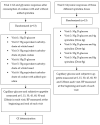Short-Term Effects of Spirulina Consumption on Glycemic Responses and Blood Pressure in Healthy Young Adults: Results from Two Randomized Clinical Trials
- PMID: 36557218
- PMCID: PMC9787962
- DOI: 10.3390/metabo12121180
Short-Term Effects of Spirulina Consumption on Glycemic Responses and Blood Pressure in Healthy Young Adults: Results from Two Randomized Clinical Trials
Abstract
The effects of spirulina consumption added in foods were investigated in two crossover clinical trials (n = 13 different healthy adults). In Trial-1 adults consumed cookies with-and-without spirulina (3.12 g per 100 g final product; 2.5 g spirulina per 50 g available carbohydrates) according to glycemic index (GI) methodology. In Trial-2, adults consumed 4 g, 6 g, and 8 g spirulina as beverage diluted in 50 g D-glucose vs. 50 g plain D-glucose. Capillary blood glucose samples were collected at 0, 15, 30, 45, 60, 90, and 120 min and blood pressure (BP) was measured at beginning and end of each visit in both trials. Trial-1: both cookies with and without spirulina provided medium GI values (59 and 60, respectively, on glucose-scale), but no significant differences were found for BP. Trial-2: both 4 g and 8 g spirulina lowered postprandial glucose at 120 min (95% CI: -1.64 to -16.12 and -1.23 to -15.87, respectively). The results explained 29% of variation. Only 8 g spirulina decreased significantly 90-120 min area under the curve (AUC) for glucose and systolic BP (-4%). No differences were found for fasting glucose. Adding spirulina to cookies did not affect glucose responses and BP. Only 8 g provided significantly lower 90-120 min-AUC for glucose and BP compared to 4 g, 6 g-and-D-glucose, indicating advantages to glycemic control and hypertension.
Keywords: appetite; blood pressure; cookies; dose; glycemic index; glycemic response; healthy adults; spirulina.
Conflict of interest statement
The authors declare no conflict of interest. The funders had no role in the design of the study; in the collection, analyses, or interpretation of data; in the writing of the manuscript; or in the decision to publish the results.
Figures




Similar articles
-
Effect of Incorporating Bay Leaves in Cookies on Postprandial Glycemia, Appetite, Palatability, and Gastrointestinal Well-Being.J Am Coll Nutr. 2017 Sep-Oct;36(7):514-519. doi: 10.1080/07315724.2017.1326324. Epub 2017 Aug 30. J Am Coll Nutr. 2017. PMID: 28853992 Clinical Trial.
-
Short-term effects of six Greek honey varieties on glycemic response: a randomized clinical trial in healthy subjects.Eur J Clin Nutr. 2018 Dec;72(12):1709-1716. doi: 10.1038/s41430-018-0160-8. Epub 2018 Apr 24. Eur J Clin Nutr. 2018. PMID: 29686412 Clinical Trial.
-
Effects of soy-soluble fiber and flaxseed gum on the glycemic and insulinemic responses to glucose solutions and dairy products in healthy adult males.J Am Coll Nutr. 2013;32(2):98-110. doi: 10.1080/07315724.2013.767579. J Am Coll Nutr. 2013. PMID: 24015717 Clinical Trial.
-
Acute effect of equicaloric meals varying in glycemic index and glycemic load on arterial stiffness and glycemia in healthy adults: a randomized crossover trial.Eur J Clin Nutr. 2019 Jan;73(1):79-85. doi: 10.1038/s41430-018-0182-2. Epub 2018 May 17. Eur J Clin Nutr. 2019. PMID: 29777241 Clinical Trial.
-
Short-term effects of a low glycemic index carob-containing snack on energy intake, satiety, and glycemic response in normal-weight, healthy adults: Results from two randomized trials.Nutrition. 2017 Oct;42:12-19. doi: 10.1016/j.nut.2017.05.011. Epub 2017 May 31. Nutrition. 2017. PMID: 28870473 Clinical Trial.
Cited by
-
Phycochemistry and pharmacological significance of filamentous cyanobacterium Spirulina sp.Bioresour Bioprocess. 2025 Apr 3;12(1):27. doi: 10.1186/s40643-025-00861-0. Bioresour Bioprocess. 2025. PMID: 40178689 Free PMC article. Review.
-
Effects of spirulina supplementation alone or with exercise on cardiometabolic health in overweight and obese adults: a systematic review and meta-analysis.Front Nutr. 2025 Jun 27;12:1624982. doi: 10.3389/fnut.2025.1624982. eCollection 2025. Front Nutr. 2025. PMID: 40655486 Free PMC article.
References
-
- Administration F.a.D. GRAS Notification for Spirulina Microalgae. [(accessed on 1 July 2022)];2002 Available online: https://www.cfsanappsexternal.fda.gov/scripts/fdcc/index.cfm?set=GRASNot....
-
- WHO/FAO World Health Organization & Food and Agricultural Organization of the United Nations Safety Evaluation of certain Food Additives: Prepared by the Eighty-Sixth Meeting of the Joint FAO/WHO Expert Committee on Food Additives (JECFA) Nov, 2020. [(accessed on 1 July 2022)]. 9789240004580. Available online: https://www.who.int/publications-detail-redirect/9789240004580.
-
- Padalino L., Lecce L., Zittelli G.C., Lo Grieco A., Torzillo G., Del Nobile M.A., Conte A. Use of spirulina to enhance the nutritional value of durum wheat spaghetti. Food Nutr. J. 2017;2:122. doi: 10.29011/2575-7091.100022. - DOI
-
- El-Hameed A.M., El-Maatti S.A., El-Saidy S., Somaya A. Effect of adding spirulina platensis in pasta products (spaghetti) Zagazig J. Agric. Res. 2018;45:293–300. doi: 10.21608/zjar.2018.49852. - DOI
LinkOut - more resources
Full Text Sources

